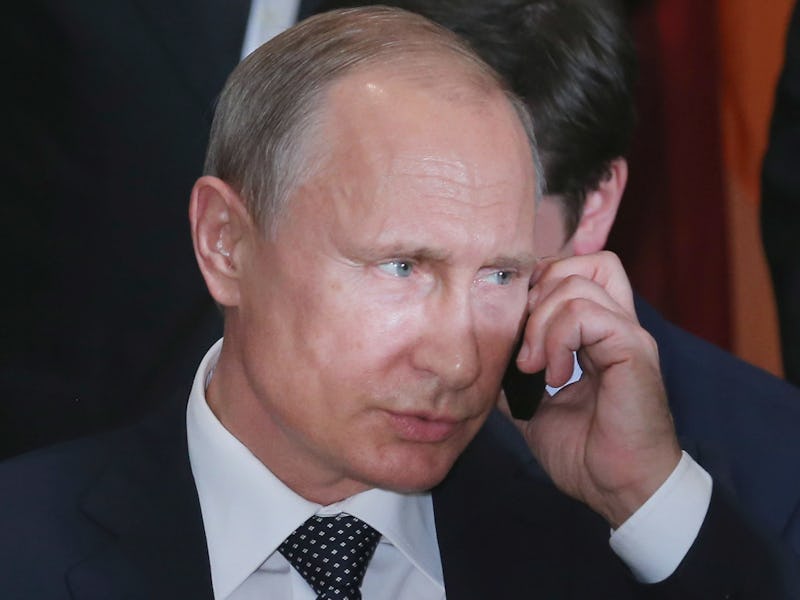Why You Shouldn't Be Worried About Russia's Satan 2 Missile That Can Destroy Texas
Nuclear war is scary, but let's not overreact.

Since the fall of the Berlin Wall and the end of the Cold War, Americans haven’t had to give much thought to the dangers of nuclear weapons hitting the shores of the United States. Sure the Bush administration falsely scared citizens into believing WMDs were in Iraq, and every once and a while Kim Jong-un tries to puff his chest, but there aren’t school drills on how to survive a nuclear bombing anymore.
America’s old Cold War rival, Russia, is giving the world new cause for concern with its updated RS-28 Sarmat — also known as the Satan 2 missile. According to the state media, which is notoriously controlled by the Russian government, the intercontinental ballistic missile (ICBM) claims it can travel faster than other missiles of its size (which means it can avoid modern defense systems) and deliver a load large enough to obliterate the entire state of Texas (which means it could obliterate the entire state of Texas).
RS-28 Sarmat
All of that sounds alarming, but the new technology doesn’t fundamentally change the intricate geo-political factors behind nuclear proliferation. Russia has had nuclear capabilities for a long time now, and Vladimir Putin, despite his proclivity for posturing, is rational enough to realize using this weapon would not be in anyone’s best interest.
But let’s imagine something changes drastically and Russia is put into a position where use of nuclear weapons is an option. How does this Satan 2 rocket change the calculations?
The RS-28 is in a class of heavy ICBMs, which means it’s really big. According to Russia, it holds 10 tons of throw weight (10 warheads each 750 kilotons) of either conventional chemical bombs or nuclear ones.
Nikolai Sokov, senior fellow at the James Martin Center for Nonproliferation Studies at the Middlebury Institute of International Studies at Monterey, tells Inverse via email that he thinks conventional warheads are more likely.
In this handout image supplied by Host photo agency / RIA Novosti, Russian President Vladimir Putin, center, Russian Defense Minister and Army General Sergei Shoigu, left, and Victory Parade Commander and Commander-in-Chief of the Russian Ground Forces, Colonel-General Oleg Salyukov, right, before the flower-laying ceremony at the Tomb of the Unknown Soldier.
“The new missile has been reported multiple times to be intended primarily (or at least in significant part) for conventional warheads instead of nuclear,” Sokov wrote. “This could be one more step toward acquiring a global stand-off conventional strike capability (which is) a very high priority – higher than nuclear, I believe – for Russia for more than a decade.”
Russia also claims the RS-28 can travel across the south pole to strike targets in the southern Americas, which would bypass the missile defense systems the U.S. has in the north.
However, Sokov says he’s skeptical Russia has that capability for nuclear weapons. He says it’s more likely for conventional warheads because a missile that size is not likely to take a depressed trajectory – which is a faster, low arching flight trajectory typically executed for nuclear first-strike scenarios.
So this missile could reach the U.S — but likely not while carrying a nuclear, Texas-destroying load.
Why make such a big missile? Jeffrey Lewis, director of East Asia Nonproliferation Program, explained in a post for ForeignPolicy.com that it has to do with Russia’s past and present economic troubles.
The former USSR has a ton of leftover warheads and few missiles to launch them. The U.S. has a similar problem but has chosen to spread those warheads over many smaller, faster launch sites. Russia doesn’t have the money to implement that strategy, so they load as many warheads into one missile as they can.
Anti-nuclear activists gather together and display a 'No Nukes' sign during an anti-nucler protest on March 10, 2013 in Kobe, Japan.
If it ever came to a point where Russia wanted to launch the warhead, the U.S. would have even more of an incentive to make a preemptive first strike, because one RS-28 can take out 10 different targets.
Bottom line is that nonproliferation experts Sokov and Lewis aren’t too concerned. Sokov notes that the life of the Russian missile has been extended many times over and “any replacement is bound to be technologically more advanced than its predecessor.”